
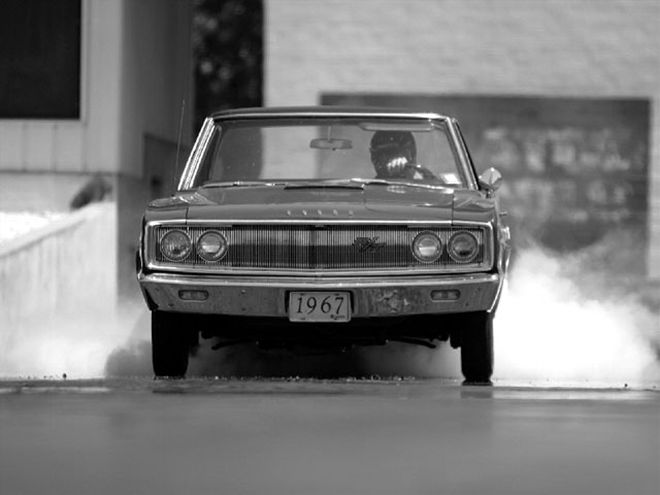 The ol' Dodge was back for a rigorous day of testing (tti H-pipe versus X-pipe, DynoMax Super Turbo versus UltraFlo mufflers). We went back another day (carb jetting and decibel readings) with the tailpipes. Initial testing was done without the tailpipes for easy pipe and muffler swaps. We were surprised and satisfied with the exhaustive test results.
The ol' Dodge was back for a rigorous day of testing (tti H-pipe versus X-pipe, DynoMax Super Turbo versus UltraFlo mufflers). We went back another day (carb jetting and decibel readings) with the tailpipes. Initial testing was done without the tailpipes for easy pipe and muffler swaps. We were surprised and satisfied with the exhaustive test results.
Most Mopar owners love the sound of their muscular V-8's. In the past, we've dyno'd and strip-tested tti's (Tube Technologies Inc.) headers and exhaust systems for small- and big-block cars. In each test, more power was obtained by picking the appropriate size tubes. We all know the right size headers, exhaust, and free-flowing mufflers look great, sound cool, and most certainly make your car quicker, but sometimes picking the right size tubes and muffler type can be a difficult task. Factor in the ability to conceal some of the compression pop you're creating, and it can be down right daunting.
What goes in, must come out, and it comes out into tubes and mufflers that will compliment peak engine efficiency without being obnoxiously loud.
X-citement
We were excited to find out tti now offers bolt-on X-pipes for our popular Mopar musclecars. Now with the choice of H or X intermediate pipes from tti, we wanted to see, feel, and hear the difference at the track. In recent years, NASCAR, drag racers, and late-model V-8 musclecars have used X-pipes with good results. We recall Dave Dudek's F.A.S.T. class, 11-second Hemi Challenger realizing gains while dyno-testing a 2 1/2-inch X-pipe against an H-pipe. We wondered if the X-pipe would be beneficial in a 3-inch diameter on our wedge-powered B-Body since it features longer intermediate tubes.
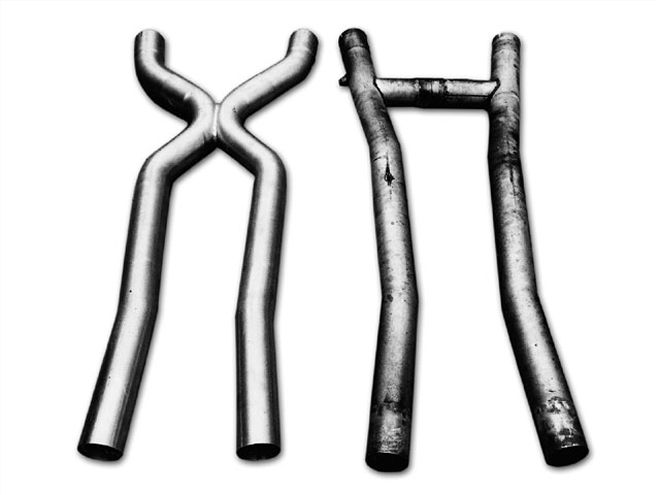 TTI's new X-pipe (on the left) was easy to swap out with tti's 7-year-old H-pipe. We were pleasantly surprised. We used hi-temp anti-seize. Most combinations will see definite improvements in the mid-range torque and horsepower using an X-pipe. on the R/T, the X-pipe delivered a smoother idle and powerband with an improved 60 ft. and e.t. The X-pipe also impressed us with less sound decibels to deal with.
TTI's new X-pipe (on the left) was easy to swap out with tti's 7-year-old H-pipe. We were pleasantly surprised. We used hi-temp anti-seize. Most combinations will see definite improvements in the mid-range torque and horsepower using an X-pipe. on the R/T, the X-pipe delivered a smoother idle and powerband with an improved 60 ft. and e.t. The X-pipe also impressed us with less sound decibels to deal with.
H-pipes and X-pipes optimize the flow of the exhaust by creating a balance between the different banks in a V-configured engine. While both the H and the X add to the scavenging ability of the exhaust from the engine, the X-pipe helps those individual exhaust pulses push and pull each other through the exhaust system.
Test Prep-X
We needed to pull off this track test with ease, so we trial fitted the new/old pipes and mufflers at our home garage. The H-pipe, turbo muffs, and tailpipes were tti issued and tested over seven years ago. The old muffs and tailpipes were tough to remove and required a muffler chisel. This caused damage to the turbo muffler outlets, but not to the tailpipes. In all fairness, the H, X-pipe, and muffs would be tested without the tailpipes. Once the best combo was found, the tailpipes would be installed for a return track test for tuning and decibel reading.
Strip X-citement
The veteran strip-test mule was driven to E-Town with tools, tires, tti X-pipe, and Dynomax UltraFlo mufflers. The DynoMax Super Turbos were hangin' on the H-pipe for the ride. without tailpipes, the 90-minute ride was a bit too smelly and noisy.
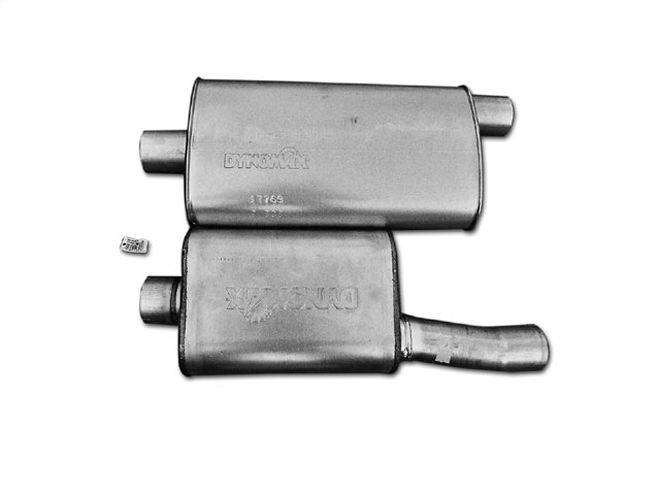 Up top, the DynoMax Super Turbo muffler shows off a 20-inch long case, which gives it six more inches of sound absorption than the UltraFlo. TTI welds a special mandrel-bent inlet pipe to the UltraFlo for a perfect fit to tti's exhaust systems. In our shootout, the UltraFlo was the noise and performance king muffler. The UltraFlo put out seven more decibels than the Super Turbo-that's more noise to consider.
Up top, the DynoMax Super Turbo muffler shows off a 20-inch long case, which gives it six more inches of sound absorption than the UltraFlo. TTI welds a special mandrel-bent inlet pipe to the UltraFlo for a perfect fit to tti's exhaust systems. In our shootout, the UltraFlo was the noise and performance king muffler. The UltraFlo put out seven more decibels than the Super Turbo-that's more noise to consider.
We were anxious to hit the track and try out the new X-pipe and UltraFlo's, but it takes an hour to set up the R/T for the strip-unload the trunk and passenger compartment, mount the Hoosiers, disconnect the front sway bar, adjust the QA1 shocks, and set the pinion snubber. This gives the motor awhile to cool down to race temp (about 160 degrees before each launch).
On our baseline pass with the H-pipe and turbo mufflers, the 440 propelled us to 11.15 at 121.20 mph. On warm days, we normally don't hot-lap it, but we took another time shot and slowed to 11.22 at 120.83 mph. we borrowed the sound meter from E-town and it read a quiet 93 decibels.
Next up to bat would be the DynoMax UltraFlo mufflers with their advantageous straight-through design. For good preparation, the ends of the H-pipe were coated with high-temp anti-seize during trial fitting. The turbo's easily pulled off, and the Ultra Flos slipped on. The deep breathing/exhausting wedge loved those straight-through mufflers right from the get-go. We realized the added power in the burnout box. Going down the track, newfound power was felt throughout the power band, especially at the upper rpm. This time, we ran 11.01, (it was 79 degrees at this point). The Ultra Flos managed to knock off .14-second and increased trap speed by 1.29 mph, that's a big time improvement from just a muffler swap! The price paid for the added performance was a noise reading of 100 decibels-kind of loud.
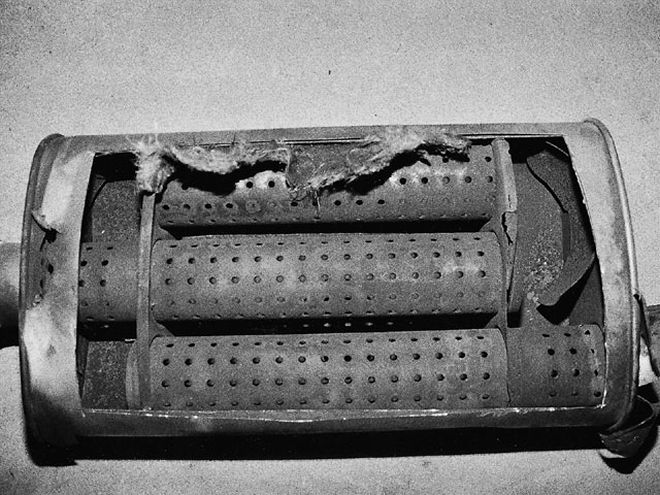 Here's the rusted-out and cut-away 7-year-old Dynomax Super Turbo that lead us to this test. With a 3-inch inlet/outlet and baffles, this hi-flow muffler outperforms many other turbo mufflers. The Super Turbo has two patented flow directors to channel the exhaust flow where it makes two turns inside the muffler.
Here's the rusted-out and cut-away 7-year-old Dynomax Super Turbo that lead us to this test. With a 3-inch inlet/outlet and baffles, this hi-flow muffler outperforms many other turbo mufflers. The Super Turbo has two patented flow directors to channel the exhaust flow where it makes two turns inside the muffler.
Our original intentions were to test both types of mufflers on the X-pipe, but we declined after the Ultra Flo results. The collector-reducers were also previously coated with anti-seize to ease swapping the H- and X-pipe. Besides, tti's components have always proven to provide ease of installation and fit. Next, the tti modified-to-fit UltraFlos were hung in place and attached to the X.
After firing up the mule with the X-pipe, we noticed a quieter, smoother sounding exhaust note. All present commented the X-pipe produced a more pleasant tone. Remarkably, the X-pipe seemed to slightly smooth out the idle and throttle response. This was confirmed with a best, for the day, 1.56 sixty-foot time. Ironically, the quarter-mile e.t. was nearly identical to the H-pipe. At this point, the ambient temperature was up to 82 degrees. We were happy the X-pipe was helping the R/T go as fast as the H-pipe, but with a smoother idle, better throttle response, and less noise (decibels were down to 97), we couldn't go wrong.
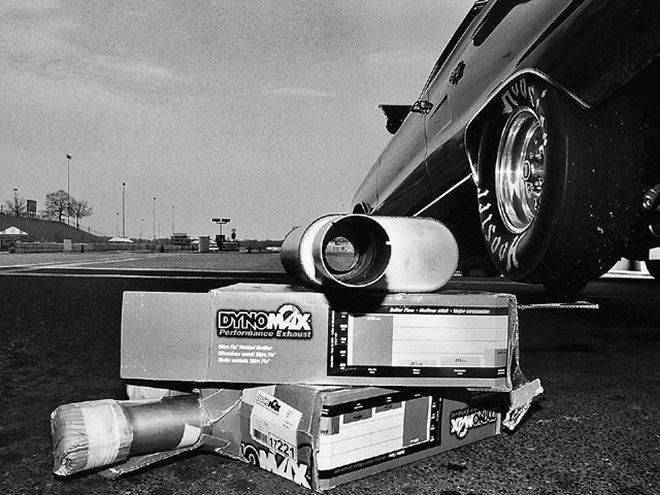 As seen here on the E-Town tarmac, the UltraFlo is a straight-through muffler for maximum flow and power. It is built with CRF (continuous roving fiberglass) to provide better sound absorption (more area) than a glass pack, while delivering a powerful sound. Take notice, most of the F.A.S.T. (factory appearing stock tire) class racers use UltraFlo mufflers.
As seen here on the E-Town tarmac, the UltraFlo is a straight-through muffler for maximum flow and power. It is built with CRF (continuous roving fiberglass) to provide better sound absorption (more area) than a glass pack, while delivering a powerful sound. Take notice, most of the F.A.S.T. (factory appearing stock tire) class racers use UltraFlo mufflers.
Satisfied with the results, we packed it in and called it a day. Many X-pipe converts will notice their engine A/F will richen up. After a plug check we didn't notice any difference. An effort towards leaner jets was an afterthought for another day. This would enable us to install the tailpipes in the comfort of our home garage.
X-Back Track
Once back to the track, we were faced with a day showing more heat and humidity along with a lower barometric pressure. To a drag racer this only means a slower car. The unfavorable air slowed the baseline a tenth to 11.11 at 121.10 mph. One of the benefits of having a complete exhaust system-the R/T was now two decibels quieter with much less interior noise.
On this sultry day (86 degrees, 73 percent humidity and 29.80 barometer), we next decided to try leaner secondary jets (from 78 to 76). We thought on this bad air day that leaner would be meaner; instead we slowed to an 11.17 at 120.62. Apparently, our wedge wanted more fuel. Would a move to 80 secondary jets help?
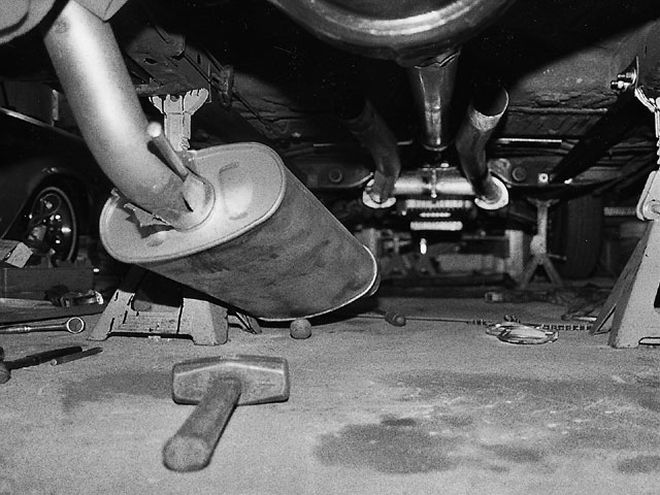 Parts removal and trial fitting were done at home to prevent any hang-ups at the track. The outlet of this 7-year-old Super Turbo was shredded with a muffler chisel to save the same age tti tailpipe. All the new and used tti exhaust components fit well together. Again, hi-temp anti-seize was used on all exhaust connections and components.
Parts removal and trial fitting were done at home to prevent any hang-ups at the track. The outlet of this 7-year-old Super Turbo was shredded with a muffler chisel to save the same age tti tailpipe. All the new and used tti exhaust components fit well together. Again, hi-temp anti-seize was used on all exhaust connections and components.
Back in the pits, we upped the carb mixture on the Holley HP in a last ditch effort. Testing with worsening weather conditions, even with one-hour cool-downs, is not advantageous when considering engine heat sink. Out of the hole the 60-foot e.t was back, and the quarter e.t was only two hundredths faster. At that point we decided we would try tuning our combo on a different day with better weather conditions. We learned from testing the importance of matching tolerable exhaust tones with desirable performance gains, while finding that happy medium.
Conclusion
The X exhibited a nice, new sound, while still sounding like a rocking big-block. With three less decibels, the quieter tti X-pipe is there to stay on the R/T. Even though our combo didn't e.t. any better with the X-pipe (possibly because of less than favorable weather conditions when tested), the idle and throttle response feels smoother and stronger. The big surprise was the muffler swap; the UltraFlo's are definitely an improvement. We were impressed at how the X-pipe and Ultra Flos teamed up to give us our best 60-foot and quarter-mile e.t ever; this on a day that was thirty degrees warmer.
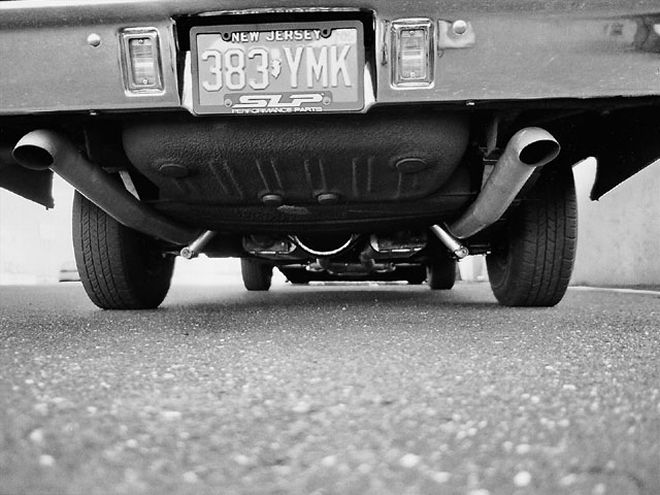 Here's the finished look with the 7-year-old tti tailpipes joined to the X-pipe and the Ultra Flos. This is the exhaust configuration for our return test-and-tune that was faced with worse weather conditions. The tailpipes lowered the decibels a few points and reduced interior noise to a more tolerable level for the 90-minute ride to-and-from E-Town. Running without tailpipes on a street-driven car is not a healthy idea.
Here's the finished look with the 7-year-old tti tailpipes joined to the X-pipe and the Ultra Flos. This is the exhaust configuration for our return test-and-tune that was faced with worse weather conditions. The tailpipes lowered the decibels a few points and reduced interior noise to a more tolerable level for the 90-minute ride to-and-from E-Town. Running without tailpipes on a street-driven car is not a healthy idea.
Dragstrip Results
*Sound meter was held 50-feet from the burnout box.
Decibel reading was from a steady 5-second, 5,000-rpm burnout.